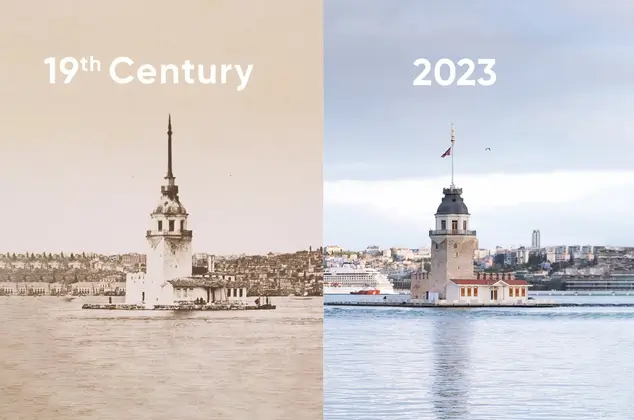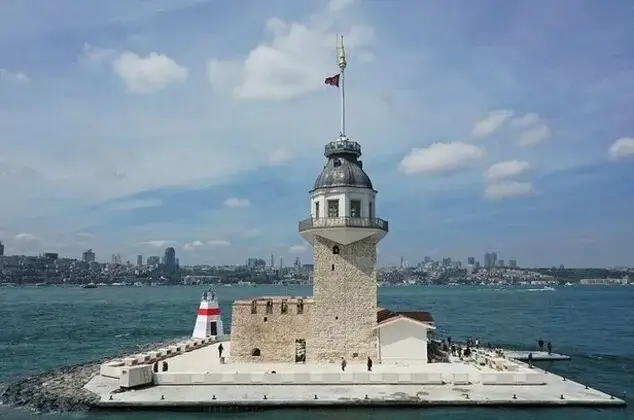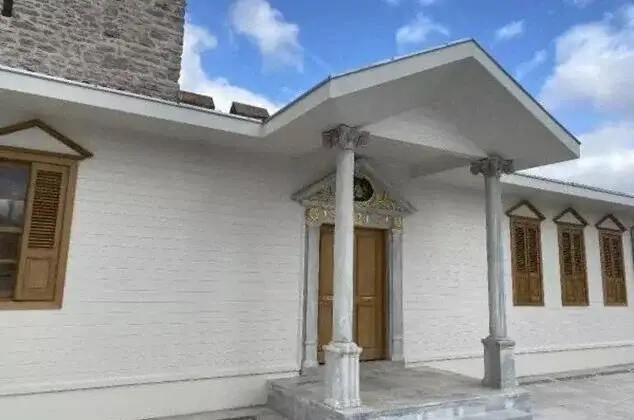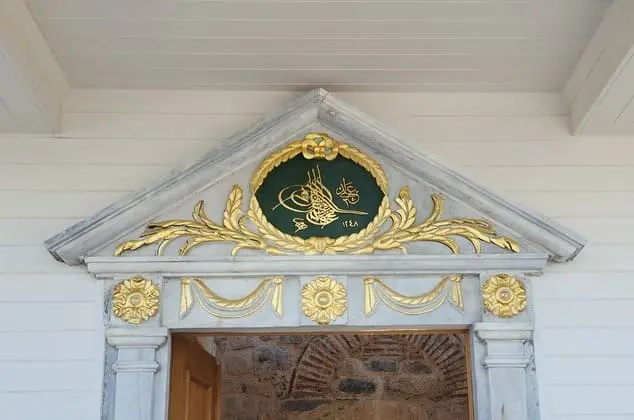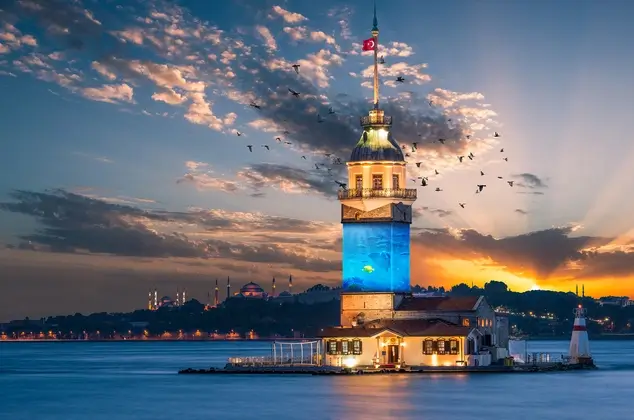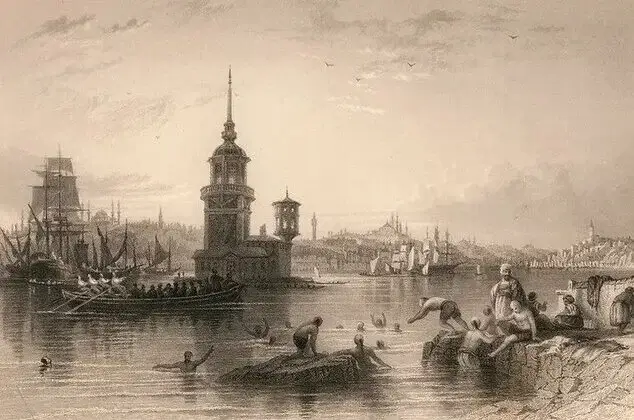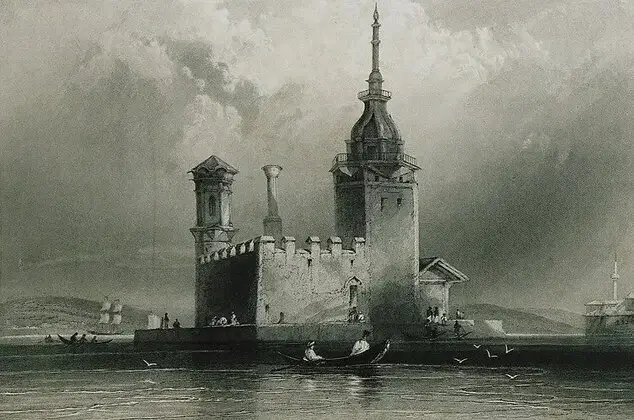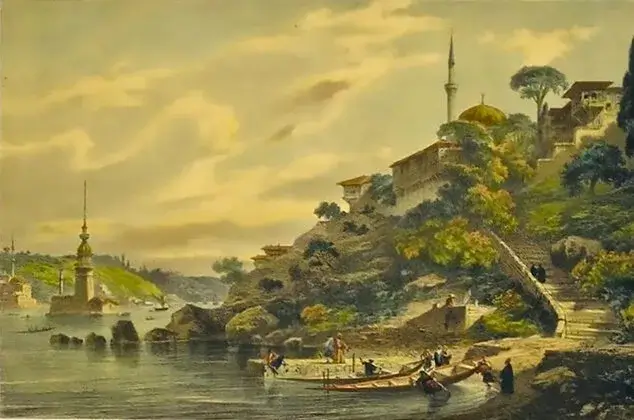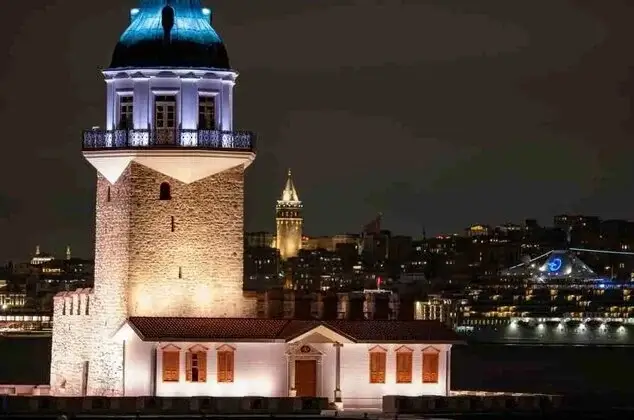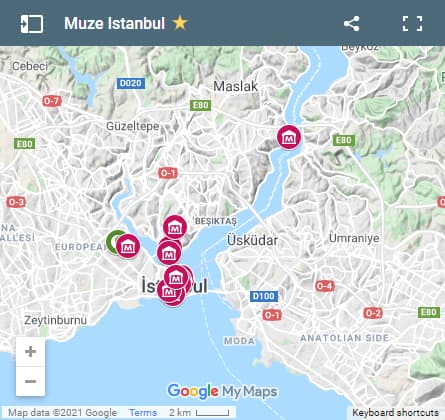MAIDEN'S TOWER MUSEUM

The Maiden’s Tower ( Turkish: Kız Kulesi ), also known as Leander’s Tower ( Tower of Leandros) since the medieval Byzantine period, is a tower on a small islet at the southern entrance of the Bosphorus strait, 200 m (220 yd) from the coast of Üsküdar neighborhood in İstanbul. It is one of the most popular landmarks and monuments of the city, with a history that spans over two millennia.
The tower was originally built by the Athenian general Alcibiades in 408 BC as a custom station for ships coming from the Black Sea. It was later rebuilt and used as a defense tower by the Byzantine emperors, who connected it to the Asian shore with a chain to prevent enemy ships from entering the Bosphorus. During the Ottoman conquest of Constantinople in 1453, the tower was destroyed and then reconstructed by Sultan Mehmed II. It served as a lighthouse, a quarantine station, and a military base throughout the Ottoman era.
Today, the tower is a monument-museum under the management of the culture and tourism ministry. It also hosts a pastry shop to cater to visitors’ tastes. The tower can be reached by boat from Üsküdar or Galataport piers. It is open every day from 09:00 to 20:00. But what makes the tower so fascinating are the legends and stories that surround it. There are many tales of love, tragedy, and mystery that have been told about the tower over the centuries.
As Ancient and Magnificent as İstanbul: The Story of the Maiden's Tower.
BCE 410
According to historical evidence, the tower, which is thought to have been built in 410 BC, was built by the Athenian Commander Alcibiades. At that time, ships passing through the strait were used to control and collect taxes.
1143-1180
A defence tower was built on the island by the Eastern Roman Emperor, Manuel Komnenos the First, in the 12th century. A chain was stretched between this tower and a tower located next to the Mangana Monastery in Sarayburnu (the section where the sea walls were restored) to control the entry and exit of ships through the Bosphorus.
1453 Conquest of Constantinople
After the Conquest, Sultan Mehmed the Conqueror (Fatih Sultan Mehmet) had a new castle built at this location. A guard unit was placed in the castle. Every evening after bedtime and at dawn, the Mehter watch began to play in the tower. It became a tradition to fire cannon shots from the Maiden's Tower during holidays and sultan’s visits to the seaside palaces, and when they ascend to the throne.
1660-1730
A lantern was placed on the northern part of the wooden tower by Sultan III, Ahmed's Grand Vizier, Nevşehirli Damat İbrahim Pasha, to illuminate the way for ships coming from the Black Sea and Marmara at night. Since then, the tower ceased being a castle and served primarily as a lighthouse.
1830-1837
Between 1830 and 1831, the tower was converted into a quarantine hospital to prevent the cholera epidemic from spreading to the city. During the plague epidemic in which twenty to thirty thousand people died between 1836-1837, some of the patients were isolated in the hospital established here, and the spread of the epidemic was quelled by quarantine. Passengers and patients were also quarantined in the Maiden’s Tower during the cholera outbreak that occurred in Trabzon in 1847.
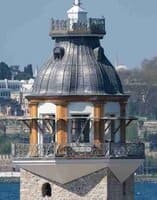
1857
A French company added a lantern to the tower, which has since been transferred to the Lighthouses Administration.
1926
After the lantern was transferred to the İstanbul Port Authority, it was used as a gas tank in addition to its lantern function.
1959
The Maiden's Tower was also used as a radar station for a while. For maritime transportation navigation safety, a light was turned on in the tower in the evenings, and a foghorn was blown in low-visibility weather. In addition, until 1983, since the distance of the Harem and Port guidance stations is short, the duties of 24-hour notification and control of all ships passing through the strait was performed by only two officers of the Maritime Enterprises.
1964
This location was used as a surveillance and radar station under the Ministry of National Defence.
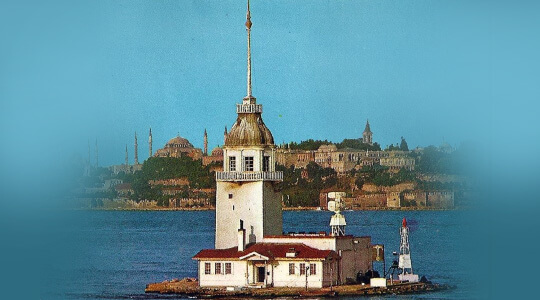
1983-1992
In 1983, the Maiden's Tower was transferred to the Maritime and Port management of Türkiye. The building was also used as a cyanide storage facility. The cyanide was moved to a storage facility in Tuzla after a decision by the İstanbul Metropolitan Municipality Council in 1992. In May 1992, the tower was used by poets for a period and declared as the "Republic of Poetry".
1994
In 1994, the tower was transferred from the Ministry of Transport to the Naval Forces Command.
1995-2000
After an extensive restoration process, the tower was rented to a private facility for tourist purposes.
2023
The Maiden’s Tower, one of the crown jewels of the Bosporus in İstanbul, has been renovated in accordance with the restoration plan carried out during the reign of the Ottoman Sultan Mahmud II, about 200 years ago. The tower was reopened to visitors on Thursday May 11th 2023 after a lengthy and meticulous 2-year restoration under a Culture and Tourism Ministry project.
İstanbul Maiden’s Tower: A Symbol of Love and Mystery
The Princess and the Snake
According to this legend, a Byzantine emperor had a beautiful daughter who was prophesied to die from a snake bite on her 18th birthday. To protect her from this fate, the emperor built a tower in the middle of the sea and locked her inside. He hoped that no snake could reach her there. However, on her birthday, he brought her a basket of fruits as a gift. Unknown to him, a venomous snake was hiding inside the basket. When the princess reached for an apple, the snake bit her and she died in her father’s arms.
The Hero and Leandros

One of the first and most popular legends of the Maiden’s Tower is based on an ancient Greek myth of two lovers who lived on opposite sides of the Hellespont (the strait that separates Europe and Asia). Hero was a priestess of Aphrodite, the goddess of love and beauty in Greek mythology. She lived in a tower near Sestos (today’s Çanakkale), at the edge of the Hellespont. She was forbidden to love because she was a nun and had no relationship with men.
Leandros was a young man from Abydos (today’s Çanakkale), who saw Hero at a festival and fell in love with her at first sight. He managed to talk to her and convince her to return his love. They decided to meet secretly every night at Hero’s tower.
Every night, Hero would light a fire on top of her tower to guide Leandros, who would swim across the strait to meet her. They would spend the night together and before dawn, Leandros would swim back to his home. They kept their love hidden from everyone for a long time. However, one stormy night, their fate changed. The wind blew out Hero’s fire and Leandros lost his way in the dark and stormy waters. He drowned in the waves and his body washed up on the shore near Hero’s tower. When Hero saw his dead body on the shore, she was overcome by grief and despair. She threw herself from the tower into the sea and died with him.
Some versions of this legend place Hero’s tower in İstanbul instead of Sestos, and identify it with the Maiden’s Tower. According to this version, Leander was a Byzantine soldier who fell in love with Hero, a nun who lived in the tower. The rest of the story is similar to the original myth
The Battal Gazi and the Byzantine Princess

This legend is inspired by a real person, Battal Gazi, who was a brave Muslim warrior who fought against the Byzantine Empire in the 8th century AD. According to this legend, Battal Gazi, who came to besiege İstanbul (Constantinople), set up his headquarters on the shore in front of the Maiden’s Tower and stayed there for seven years. The main reason why Battal Gazi stayed on the shores of Üsküdar for so long was that he fell in love with the Feudal Lord’s daughter. The Üsküdar Feudal Lord, afraid of Battal Gazi, locked his daughter and the treasures in the tower. Battal Gazi, who returned to Üsküdar after completing his Damascus campaign, came to the Maiden’s Tower by boat and took the Feudal Lord’s daughter and the treasures. Then he jumped on his horse and left Üsküdar. The well-known saying “Atı alan Üsküdar’ı geçti” (He who takes the horse passes Üsküdar) comes from this story.
The Maiden’s Tower is more than just a tower on the sea; it is a symbol of İstanbul’s rich and diverse history and culture. It is a place where you can watch a stunning sunset, or learn about the legends that surround it. Don’t miss this unique attraction when you visit İstanbul!
Architecture of Maidens Tower:
The Maiden’s Tower is not only a historic landmark on the sea, but also a remarkable example of architectural design. The tower has undergone several changes and renovations over the centuries, reflecting the different periods and influences of its builders and users.
The original tower was built by the Athenian general Alcibiades in 408 BC as a wooden structure on a small rock. It was later rebuilt and fortified by the Byzantine emperors, who added a stone wall and an iron chain to connect it to the Asian shore. The tower had a circular shape and a conical roof, and was used as a defense tower and a customs station.
The tower was destroyed and rebuilt several times by natural disasters and wars. In 1725, the Ottoman grand vizier Damad Ibrahim Pasha ordered a reconstruction of the tower, which gave it its current shape and size. The tower was made of stone and brick, and had five floors and an octagonal plan. It was decorated with baroque elements such as arches, cornices, and windows. The tower was also equipped with a lantern and used as a lighthouse.
In 1833, Sultan Mahmud II ordered another restoration of the tower, which added more details and ornaments to its exterior and interior. The tower was painted white and red, and had wooden balconies and stairs. The interior was divided into rooms for different purposes, such as a kitchen, a dining room, a bedroom, and a bathroom. The tower also had a fireplace, a fountain, and a clock.
In 1857, a French company installed a new lantern on the tower, which increased its height and visibility. The lantern had a metal frame and glass panels, and was powered by gas. The tower continued to serve as a lighthouse until 1926.
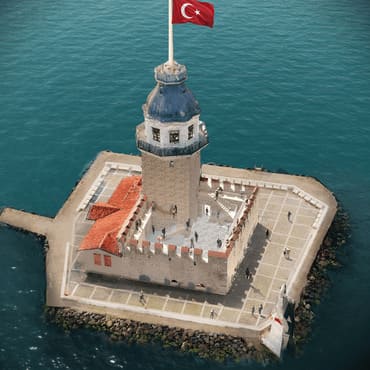
In 1998, the tower underwent another renovation, which preserved its historical features while adding modern facilities. The tower was reinforced with steel supports to withstand earthquakes and tsunamis. The interior was redesigned to accommodate a museum and a restaurant.
In 2023, The Maiden’s Tower, has reopened to the public on May 11th after a major two-year restoration project by the Ministry of Culture and Tourism. The tower, whose history dates back to 410 BC1, has been restored faithfully to its state in the early 19th century, during the reign of Ottoman Sultan Mahmud II (1808-1839)
The restoration work was carried out by a team of experts, including Feridun Çılı of İstanbul Technical University, antiquities scholar Zeynep Ahunbay, and architect Han Tümertekin, under the supervision of a scientific committee. The tower was damaged by salt and other chemicals in the concrete and cement used in previous renovations, and the carrying columns and beams were not attached to each other. The team used various technologies, such as chemical analysis, laser scanners, and georadar imaging, to reveal the problems in the structure and to strengthen the historical main walls with invisible braces made of stainless steel. The original walls of the castle section were also revealed, and the dome and finial were covered with lead and gold leaf respectively.
The tower also underwent extensive earthquake measures, such as integrated piles made of steel and concrete around the islet, reinforced concrete support beams around the perimeter, and wave barriers around the platform. The tower now has walkways around the ramparts of the courtyard walls for visitors to climb up and enjoy the view of İstanbul.
The reopening of the tower was celebrated with a spectacular light and sound show between the Maiden’s Tower and the nearby Galata Tower. The tower is set to reclaim its place as a major tourist attraction in İstanbul, offering a unique experience of history and culture.
For more information on the restoration work visit kizkulesi.gov.tr
The Maiden’s Tower is a unique architectural masterpiece that combines history and style. It is a witness to the changing times and cultures of İstanbul. It is a place where you can admire the beauty and craftsmanship of its design, while learning about its fascinating stories.
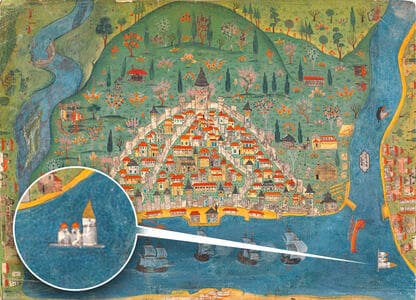
Matrakcı Nasuh's Historic Map.”
|Click to Enlarge|
How to get to Maiden’s Tower Museum?
You can reach the Maiden's Tower by private boats departing from the Üsküdar-Salacak and Karaköy (GoogleMaps) piers. If you are accommodated on the European side of İstanbul, Karaköy pier is the best way to get around.
Visiting Hours, Tours and Tickets
Museum Pass owners can access the Maiden's Tower Monument Museum, but an extra 5 € (Euro) boat transportation fee should be paid at piers. Entrance fee for visitors who do not possess a Museum Pass Türkiye or İstanbul is 27€ (Euro) for ticket and 5 € (Euro) for boat transportation. You can also purchase e-tickets from our official page. Turkish citizens with a MÜZEKART can enter the Maiden's Tower Museum for free, but a 75 Turkish Lira transportation fee must be paid at the pier. Boat trips from Karaköy Pier are operated daily between 09:30 and 17:00. Boats to the Maiden’s Tower leave from Üsküdar-Salacak pier every day of the week between 10:00 am and 16:00 pm. You can buy tickets at the office in front of the pier. The following timetables are from Karaköy and Salacak (Üsküdar) heading to the Maiden’s Tower:
Note: Delays and disruptions may occur during the winter season.
| # | Karaköy | Maiden's Tower |
|---|---|---|
| (1) | 09:30 | 10:30 |
| (2) | 11:00 | 12:00 |
| (3) | 12:30 | 13:30 |
| (4) | 14:00 | 15:00 |
| (5) | 15:30 | 16:30 |
| (6) | 17:00 | 18:00 |
| # | Salacak | Maiden's Tower |
|---|---|---|
| (1) | 10:00 | 11:15 |
| (2) | 11:30 | 12:45 |
| (3) | 13:00 | 14:15 |
| (4) | 14:30 | 15:45 |
| (5) | 16:00 | 17:15 |
See Also
- https://kizkulesi.gov.tr/ | Maiden's Tower Has Reopened Its Eyes!
- https://istanbuluseyret.ibb.gov.tr/ | Live Cam
- https://basin.ktb.gov.tr/ | MINISTER ERSOY: "Maiden's Tower Will Open With Light and Laser Show at 21:00 Today"
- https://www.aa.com.tr/ | İstanbul's Maiden's Tower reopens after 2-year restoration
- https://www.thebyzantinelegacy.com/ | Maiden's Tower






